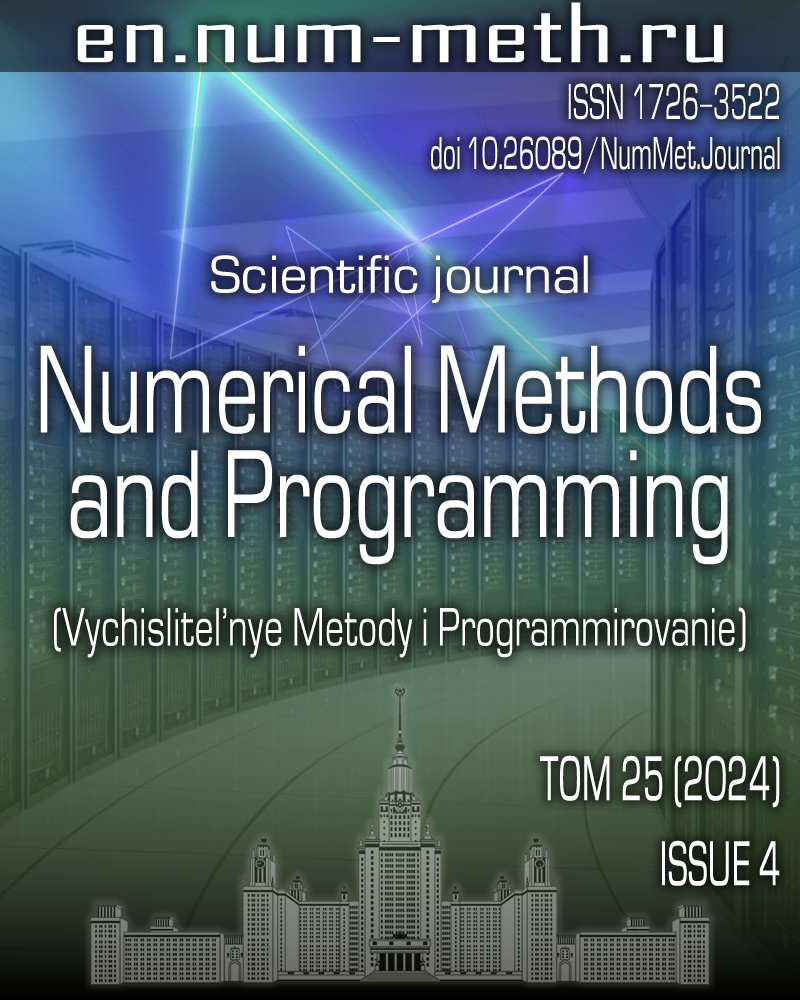DOI: https://doi.org/10.26089/NumMet.v25r434
Using parallel computing in the transition interface sampling method implementation
Keywords:
Abstract
Numerical estimation of the reaction rate constant is an important task in the field of bioinformatics. This constant provides information on the binding kinetics of the protein complex components. One approach to perform this estimation is to apply the transition interface sampling method, which is based on the simulation of transitions between different states of the modeled system along several trajectories. Each state and transition is characterized by the estimated energy of the interaction between the components of a protein complex. In this paper, we provide a way to apply parallel computing to multiple trajectory construction. We present the principles of using MPI technology and Intel oneTBB library, along with the demonstration of various experimental results. The purpose of the study is to determine the most effective parallel programming tool for constructing multiple trajectories in the transition interface sampling method within the given computational systems.
Published
Issue
Section
References
- S. S. Khruschev, A. M. Abaturova, A. N. Diakonova, et al., “Multi-Particle Brownian Dynamics Software ProKSim for Protein-Protein Interactions Modeling,” Comput. Res. Model. 5 (1), 47-64 (2013).
doi 10.20537/2076-7633-2013-5-1-47-64 - S. V. Poluyan, D. A. Nikulin, and N. M. Ershov, “Development and Verification of a Score Function for Estimation of Intermolecular Interactions in Protein-Protein Complexes,” in Proc. Int. Conf. on ITTMM, Moscow, Russia, April 17-21, 2023 (RUDN Univ., Moscow, 2023), pp. 231-235.
https://events.rudn.ru/event/198/attachments/550/1474/ittmm-2023.pdf . Cited November 10, 2024. - D. V. Borisov and A. V. Veselovsky, “Ligand-Receptor Binding Kinetics in Drug Design,” Biomeditsinskaya Khimiya 66 (1), 42-53 (2020).
doi 10.18097/PBMC20206601042 - P. C. T. Souza, S. Thallmair, P. Confitti, et al., “Protein-Ligand Binding with the Coarse-Grained Martini Model,” Nat. Commun. 11, Article Number 3714 (2020).
doi 10.1038/s41467-020-17437-5 - S. Qin, X. Pang, and H.-X. Zhou, “Automated Prediction of Protein Association Rate Constants,” Structure 19 (12), 1744-1751 (2011).
doi 10.1016/j.str.2011.10.015 - R. Alsallaq and H.-X. Zhou, “Electrostatic Rate Enhancement and Transient Complex of Protein-Protein Association,” Proteins 71 (1), 320-335 (2008).
doi 10.1002/prot.21679 - K. Dhusia, Z. Su, and Y. Wu, “Using Coarse-Grained Simulations to Characterize the Mechanisms of Protein-Protein Association,” Biomolecules 10 (7), Article Number 1056 (2020).
doi 10.3390/biom10071056 - J. Rogal and P. G. Bolhuis, “Multiple State Transition Path Sampling,” J. Chem. Phys. 129 (22), Article Number 224107 (2008).
doi 10.1063/1.3029696 - J. Jankauskaité, B. Jiménez-Garcia, J. Dapkünas, et al., “SKEMPI 2.0: An Updated Benchmark of Changes in Protein-Protein Binding Energy, Kinetics and Thermodynamics upon Mutation,” Bioinformatics 35 (3), 462-469 (2019).
doi 10.1093/bioinformatics/bty635 - H. M. Berman, J. Westbrook, Z. Feng, et al., “The Protein Data Bank,” Nucleic Acids Res. 28 (1), 235-242 (2000).
doi 10.1093/nar/28.1.235 - A. V. Sysoyev, A. V. Gorshkov, V. D. Volokitin, et al., “Programming with oneAPI: New Course Heterogeneous Computing,” Vestn. Yuzhn. Ural. Gos. Univ. Ser. Vychisl. Mat. Inf. 11 (3), 45-58 (2022).
doi 10.14529/cmse220303 - Gh. Adam, M. Bashashin, D. Belyakov, et al., “IT-Ecosystem of the HybriLIT Heterogeneous Platform for High-Performance Computing and Training of IT-Specialists,” in Proc. 8th Int. Conf. on Distributed Computing and Grid-Technologies in Science and Education, Dubna, Russia, September 10-14, 2018. CEUR Workshop Proc. 2267, 638-644 (2018).
https://ceur-ws.org/Vol-2267/638-644-paper-122.pdf . Cited November 10, 2024. - W. E, W. Ren, and E. Vanden-Eijnden, “Simplified and Improved String Method for Computing the Minimum Energy Paths in Barrier-Crossing Events,” J. Chem. Phys. 126 (16), Article Number 164103 (2007).
doi 10.1063/1.2720838 - S. Sahni and G. Vairaktarakis, “The Master-Slave Paradigm in Parallel Computer and Industrial Settings,” J. Glob. Optim. 9 (3-4), 357-377 (1996).
doi 10.1007/BF00121679 - Programming Tool Valgrind.
https://valgrind.org . Cited November 10, 2024. - Repository with Synthetic Test and Code Fragments.
https://vcs.uni-dubna.ru/psm/multithreading . Cited November 10, 2024. - S. Williams, A. Waterman, and D. Patterson, “Roofline: An Insightful Visual Performance Model for Multicore Architectures,” Commun. ACM 52 (4), 65-76 (2009).
doi 10.1145/1498765.1498785 - M. Voss, R. Asenjo, and J. Reinders, Pro TBB: C++ Parallel Programming with Threading Building Blocks (Apress, Berkeley, 2019).
doi 10.1007/978-1-4842-4398-5
License
Copyright (c) 2024 С. В. Полуян, Н. М. Ершов

This work is licensed under a Creative Commons Attribution 4.0 International License.


